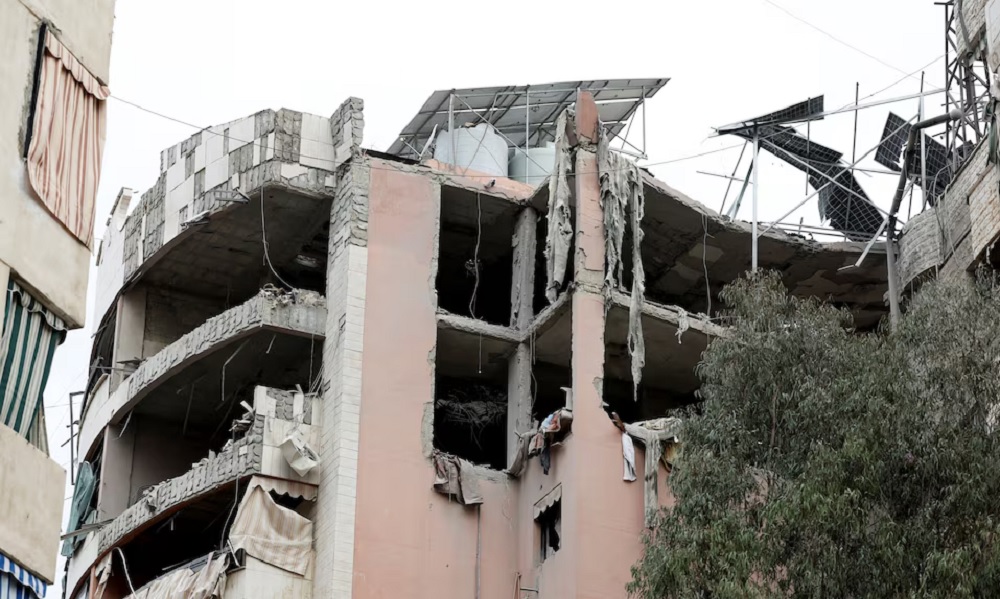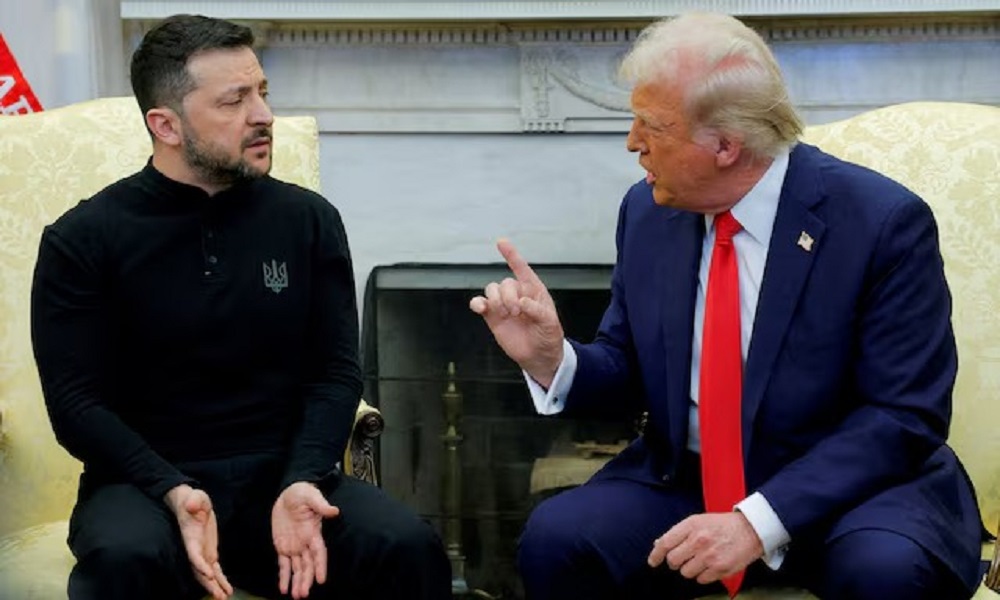World
Biden says missile that killed two in Poland may not have come from Russia

A missile that killed two people in Poland was probably not fired from Russia, US President Joe Biden said on Wednesday after an emergency meeting of NATO leaders called to discuss what Poland called a strike by a Russia-made projectile, Reuters reported.
The explosion on Tuesday at a grain facility near the Ukrainian border came as Russia unleashed a wave of missile attacks targeting Ukrainian energy infrastructure, raising concerns the conflict could spill into neighbouring countries.
According to Reuters the Polish foreign ministry said the rocket fell on Przewodow, a village about 6 km (4 miles) from the border with Ukraine. Russia denied it was responsible for the explosion but Polish officials said the missile was Russian-made.
A resident who declined to be identified said the two victims were men who were near the weighing area of a grain facility.
A Russian strike on Poland could risk widening the conflict between Russia and Ukraine as members of the North Atlantic Treaty Organization (NATO) are committed to collective defence under its Article 5, read the report.
Biden convened a meeting of leaders gathered for the G20 meeting in Bali, Indonesia, to discuss the incident. Leaders from NATO members Germany, Canada, Netherlands, Spain, Italy, France and Britain attended, as well as non-NATO member Japan and representatives from the European Union.
Asked whether it was too early to say if the missile was fired from Russia, Biden said: “There is preliminary information that contests that. I don’t want to say that until we completely investigate it, but it is unlikely in the lines of the trajectory that it was fired from Russia but we’ll see.”
The United States and NATO countries would fully investigate before acting, Biden said.
The explosion in Poland came as Russia pounded cities across Ukraine with missiles, in attacks that Kyiv said were the heaviest wave of strikes in nearly nine months of war. Some hit Lviv, which is less than 80 km (50 miles) from the border with Poland, Reuters reported.
Ukrainian President Volodymyr Zelenskiy said Russian missiles hit Poland in a “significant escalation” of the conflict. He did not provide evidence of Russia’s involvement.
“All of Europe and the world must be fully protected from terrorist Russia,” he said in a tweet after a phone call with Polish President Andrzej Duda.
Two European diplomats said Poland requested a NATO meeting under the treaty’s Article 4 for consultations among the allies. Poland was also increasing the readiness of some military units, Polish Prime Minister Mateusz Morawiecki said.
Polish officials sought to avoid inflaming the situation. Morawiecki called on all Poles to remain calm, and President Duda said there was no concrete evidence showing who fired the missile and that it was a one-off incident, read the report.
Biden told Duda in a call that Washington has an “ironclad commitment to NATO” and will support Poland’s investigation, the White House said.
The Associated Press earlier cited a senior US intelligence official as saying the blast was due to Russian missiles having crossed into Poland.
But in Washington, the Pentagon, White House and US State Department said they could not corroborate the report and were working with the Polish government to gather more information. The State Department said the report was “incredibly concerning.”
Germany and Canada said they were monitoring the situation, and the European Union, the Netherlands and Norway said they were seeking more details. French President Emmanuel Macron ordered a verification effort, while Britain was “urgently” looking into the report.
According to Reuters Russia’s defence ministry denied that Russian missiles hit Polish territory, describing such reports as “a deliberate provocation aimed at escalating the situation”.
Kremlin spokesperson Dmitry Peskov said he had no information on an explosion in Poland.
Latvian Deputy Prime Minister Artis Pabriks said the situation was “unacceptable” and it could lead to NATO providing more anti-aircraft defences to Poland and Ukraine.
Lithuanian President Gitanas Nauseda said on Twitter: “Every inch of #NATO territory must be defended!”
Ukrainian Defence Minister Oleksiy Reznikov said Kyiv had warned of the danger Russian missiles posed to neighbouring countries and called for a no-fly zone to be imposed, read the report.
“We were asking to close the sky, because sky has no borders. Not for uncontrolled missiles. Not for the threat they carry for our EU & NATO neighbours. Gloves are off. Time to win,” he said in a Twitter post.
World
As Iran tensions build, US military moves warplanes to reinforce Middle East
U.S. President Donald Trump threatened Iran on Sunday with bombing and secondary tariffs if Tehran did not come to an agreement with Washington over its nuclear program.

U.S. Defense Secretary Pete Hegseth has reinforced U.S. military capability in the Middle East with more warplanes, the Pentagon said on Tuesday, amid a more than two-week-old U.S. bombing campaign in Yemen and mounting tensions with Iran, Reuters reported.
The Pentagon’s brief statement did not specify which aircraft were being deployed or where precisely they were sent.
However, as many as six B-2 bombers have relocated in the past week or so to a U.S.-British military base on the Indian Ocean island of Diego Garcia, according to U.S. officials, speaking on condition of anonymity.
Experts say that puts the B-2s, which have stealth technology and are equipped to carry the heaviest U.S. bombs and nuclear weapons, in an ideal position to operate in the Middle East.
“Should Iran or its proxies threaten American personnel and interests in the region, the United States will take decisive action to defend our people,” Pentagon spokesperson Sean Parnell said in a statement.
The U.S. military’s Strategic Command has declined to say how many B-2s have reached Diego Garcia and noted that it does not comment on exercises or operations involving the B-2.
There is already considerable firepower in the Middle East and the U.S. military will soon have two aircraft carriers in the region, read the report.
U.S. President Donald Trump threatened Iran on Sunday with bombing and secondary tariffs if Tehran did not come to an agreement with Washington over its nuclear program.
While B-2 bombers have been employed to strike buried Houthi targets in Yemen, most experts say use of the stealthy bomber is overkill there and the targets aren’t buried so deeply.
However, the B-2 is equipped to carry America’s most potent bomb — the 30,000-pound GBU-57 Massive Ordnance Penetrator. That is the weapon that experts say could be used to strike Iran’s nuclear program.
There are only 20 B-2 bombers in the Air Force’s inventory so they are usually used sparingly.
Iran’s Supreme Leader Ayatollah Ali Khamenei said on Monday the U.S. would receive a strong blow if Trump followed through with his threats.
Revolutionary Guards Aerospace Commander Amirali Hajizadeh threatened U.S. forces in the Middle East, noting American bases in the Middle East and adding: “They are in a glass house and should not throw stones.”
One official told Reuters that the U.S. military was also moving some air defense capabilities from Asia to the Middle East.
In his 2017-2021 term, Trump withdrew the U.S. from a 2015 deal between Iran and world powers that placed strict limits on Tehran’s disputed nuclear activities in exchange for sanctions relief. Trump also reimposed sweeping U.S. sanctions.
Since then, Iran has far surpassed that deal’s limits on uranium enrichment.
Western powers accuse Iran of having a clandestine agenda to develop nuclear weapons capability by enriching uranium to a high level of fissile purity, above what they say is justifiable for a civilian atomic energy program. Tehran says its nuclear program is wholly for civilian energy purposes.
World
Israel kills Hezbollah official in deadly Beirut airstrike

An Israeli airstrike killed four people including a Hezbollah official in Beirut’s southern suburbs on Tuesday, a Lebanese security source said, further testing a shaky ceasefire between Israel and Iran-backed Hezbollah.
The Israeli military said the official – Hassan Bdeir – was a member of a Hezbollah unit and Iran’s Quds Force, and he had assisted the Palestinian group Hamas in planning a “significant and imminent terror attack against Israeli civilians,” Reuters reported.
The Lebanese security source said the target was a Hezbollah figure whose responsibilities included the Palestinian file. The Lebanese health ministry said the strike killed four people – including a woman – and wounded seven others.
It marked Israel’s second airstrike in the Hezbollah-controlled suburb of Beirut in five days, adding to strains on the U.S.-brokered ceasefire that ended last year’s devastating conflict.
The attacks on Beirut’s southern suburbs have resumed at a time of broader escalation in the region, with Israel having restarted Gaza strikes after a two-month truce and the United States hitting the Iran-aligned Houthis of Yemen in a bid to get them to stop attacking Red Sea shipping.
Hezbollah lawmaker Ibrahim Moussawi said the Israeli attack amounted to “a major and severe aggression that has escalated the situation to an entirely different level”.
Speaking in a televised statement after visiting the building that was struck, he called on the Lebanese state to “activate the highest level of diplomacy to find solutions”.
Israeli Foreign Minister Gideon Saar said the eliminated Hezbollah operative posed “a real and immediate threat”. “We expect Lebanon to take action to uproot terrorist organizations acting within its borders against Israel,” he said.
Israel dealt severe blows to Hezbollah in the war, killing thousands of its fighters, destroying much of it arsenal and eliminating its top leadership including Hassan Nasrallah.
Hezbollah has denied any role in recent rocket attacks from Lebanon towards Israel, including one that prompted Israel to carry out an airstrike on the southern suburbs last Friday.
Tuesday’s strike in the early hours appeared to have damaged the upper three floors of a building, a Reuters reporter at the scene said, with the balconies of those floors blown out.
The glass on the floors below was intact, indicating a targeted strike. Ambulances were at the scene as families fled to other parts of Beirut.
There was no advance warning, in contrast to the attack on Friday when the Israeli military announced which building it intended to hit and ordered residents to leave the area.
Lebanese President Joseph Aoun condemned the latest airstrike, calling it a “dangerous warning” that signals premeditated intentions against Lebanon, which would intensify diplomatic outreach and mobilise international allies.
Lebanese Prime Minister Nawaf Salam said the strike was a flagrant breach of a U.N. Security Council Resolution upon which the ceasefire was based, and the ceasefire arrangement.
U.S. BACKS ISRAEL
The ceasefire agreement demanded that southern Lebanon be free of Hezbollah fighters and weapons, that Lebanese troops deploy into the area, and that Israeli troops withdraw.
But each side accuses the other of failing to implement the terms fully. Israel says Hezbollah still has infrastructure in the south, while Lebanon and Hezbollah say Israel is occupying Lebanese soil by not withdrawing from five hilltop positions.
The U.S. State Department said that Israel was defending itself from rocket attacks that came from Lebanon and that Washington blamed “terrorists” for the resumption of hostilities.
“Hostilities have resumed because terrorists launched rockets into Israel from Lebanon,” a State Department spokesperson said in an email, responding to a question from Reuters seeking reaction to Tuesday’s airstrike. Washington supported Israel’s response, the spokesperson said.
The Israel-Hezbollah conflict was ignited when Hezbollah opened fire in support of Hamas at the start of the Gaza war. It escalated in September when Israel went on the offensive, declaring the aim of securing the return home of tens of thousands of people evacuated from homes in the north.
The war uprooted more than a million people and killed at least 3,768 people in Lebanon, according to a Lebanese health ministry toll from November. Dozens more have been reported killed by Israeli fire since the ceasefire.
Lebanon’s figures do not distinguish between civilians and fighters.
During the war, Hezbollah strikes killed 45 civilians in northern Israel and the Israeli-occupied Golan Heights. At least 73 Israeli soldiers were killed in northern Israel, the Golan Heights, and in combat in southern Lebanon, according to Israeli authorities.
World
Trump says Zelenskiy wants to back out of critical minerals deal

U.S. President Donald Trump said on Sunday Ukrainian President Volodymyr Zelenskiy wants to back out of a critical minerals deal, warning the Ukrainian leader would face big problems if he did.
“He’s trying to back out of the rare earth deal and if he does that he’s got some problems, big, big problems,” Trump told reporters.
“He wants to be a member of NATO, but he’s never going to be a member of NATO. He understands that.”
(Reuters)
-

 World5 days ago
World5 days agoMyanmar quake death toll hits 1,700 as aid scramble intensifies
-

 Latest News4 days ago
Latest News4 days agoSwitzerland re-establishes presence in Kabul with humanitarian office
-

 Latest News4 days ago
Latest News4 days agoPakistan plans to expel 3 million Afghan refugees this year
-

 World4 days ago
World4 days agoSouth Korea, China, Japan seek regional trade amid Trump tariffs
-

 Regional4 days ago
Regional4 days agoIran’s Khamenei warns of ‘strong’ response if US attacks
-

 Latest News3 days ago
Latest News3 days agoAfghanistan’s reconstruction is in the interest of EU: Uzbek president
-

 Latest News3 days ago
Latest News3 days agoUS won’t rest until all Americans detained in Afghanistan brought home: Rubio
-

 Latest News3 days ago
Latest News3 days agoBulgaria brings five people to trial over deaths of 18 Afghan migrants
























